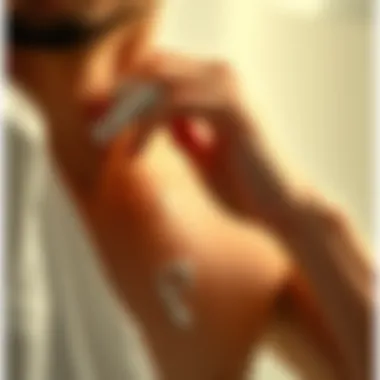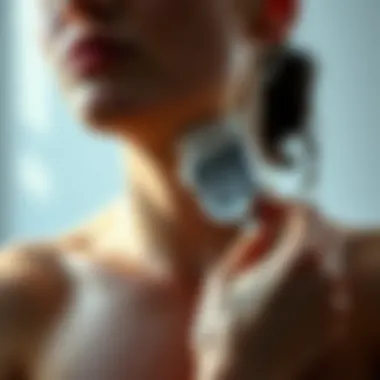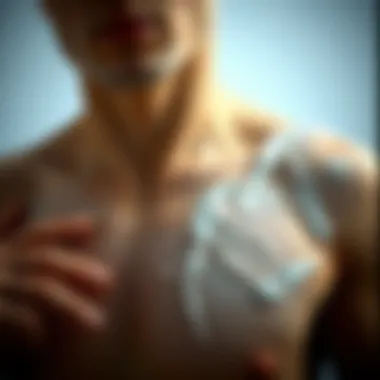Techniques for Shaving Underarms Without Cream


Intro
In the world of personal grooming, the quest for smooth underarms often takes center stage, especially for women who prioritize comfort and hygiene. Traditionally, shaving cream has been a staple tool to achieve that silky feel, providing a cushion between the razor blade and the skin. However, the idea of shaving without this commonly used product is both intriguing and practical for many.
This exploration into shaving underarms without shaving cream aims to empower individuals with insights beyond conventional wisdom. Several alternative methods exist that allow for a close shave while minimizing irritation. This article will guide you through pre-shaving preparations, discuss the essential tools required, and look at aftercare strategies to ensure skin health. Rather than merely scraping away hair, it focuses on refining the entire grooming ritual to promote personal comfort and care.
Whether you're trying to simplify your routine, avoid specific ingredients in creams, or simply seek more eco-friendly options, there are techniques to suit various preferences. By offering a blend of established practices and lesser-known insights, we'll tackle the nuances of underarm shaving that cater to all skin types and grooming philosophies.
Buckle up as we uncover these techniques, aiming for efficient grooming that pairs effectiveness with skin health.
"An informed choice opens a door to self-care that's truly tailored to you."
Let's dive into the tips and how-tos that will set the stage for a better shaving experience.
Understanding the Basics of Underarm Hair Removal
Understanding the nuances of underarm hair removal is more than just a cosmetic pursuit; it’s about embracing one's personal grooming choices and comfort. The underarm area is unique, both in its anatomy and its response to shaving techniques. For many people, maintaining smooth skin in this region can bring a level of confidence and freedom. It allows for the choice of clothing without the nagging worry of visible hair or irritation. Additionally, comprehending how one’s body reacts to various removal methods can profoundly influence one’s skin health and overall appearance.
Anatomy of the Underarm Area
The underarm, or axilla, is a complex area of skin characterized by its delicate nature. This region houses numerous sweat glands and hair follicles, making it particularly sensitive. The unique shape of the underarm, with folds and crevices, adds another layer of challenge when it comes to hair removal.
When shaving, it's crucial to recognize that skin in the armpit can be prone to ingrown hairs and irritation. Unlike smoother areas of skin, the underarm can trap hairs, leading to discomfort and potential infections if care isn’t taken. Furthermore, the hydration level of this area can vary greatly due to its proximity to sweat glands, which also affects how hair removal products and techniques work. As a result, a thorough understanding of this anatomy can help individuals tailor their shaving routines effectively.
To fully appreciate hair removal techniques, one should be aware of:
- The thickness and texture of hair in the underarm area, which tends to be coarser than that of other body regions.
- The presence of sensitive skin types that might react poorly to certain products or techniques.
- The role of sweat glands and how they affect skin health after shaving.
Common Shaving Methods and Their Downsides
While there are various methods for hair removal, some are more commonplace. Breaking them down can provide insights into why alternatives might be necessary, especially when skipping shaving cream.
- Traditional Wet Shaving: This involves using shaving cream or gel to create a barrier for the razor. It ensures a smoother glide, but can lead to product buildup and irritation for some.
- Dry Shaving: Commonly seen as the go-to option when one is in a rush, it presents its own set of challenges. Lack of moisture can lead to small nicks and increased irritation.
- Use of Disposable Razors: While convenient, these razors may not provide the cleanest cut, especially if they become dull. This can lead to uneven results and a higher chance of razor burn.
- Electric Shavers: Each has its own pros and cons. While they may minimize cuts, many do not provide as close a shave, leaving behind stubble that some may find unappealing.
These common methods can leave users feeling frustrated, especially when they result in skin irritation or unsatisfactory results. The need for effective alternatives that can smooth skin while minimizing these downsides is crucial.
In summary, understanding the basics of underarm hair removal lays the foundation for informed decisions. The knowledge gained from grasping anatomy and evaluating common shaving methods empowers individuals to adopt techniques that suit their unique needs and skin types.
Pre-Shaving Preparation
Pre-shaving preparation plays a pivotal role in ensuring a smooth and irritation-free shaving experience. It’s similar to laying down a solid foundation before building a house; without it, the entire structure might be shaky. Adequate preparation not only minimizes discomfort but also enhances the overall results of the shaving process. In the underarm area, where skin is delicate, taking the time to properly prepare can make all the difference.
Exfoliation Techniques for Smooth Skin
Exfoliation is an essential step that shouldn’t be skipped. This process involves removing dead skin cells, which helps to prevent ingrown hairs and allows for a closer shave. There are several ways to exfoliate the underarm area:
- Physical Exfoliation: Using a gentle scrub or a loofah can effectively slough off dead skin. Look for products that contain natural ingredients like sugar or salt mixed with oils for added hydration.
- Chemical Exfoliation: Another option is to use exfoliating acids, like alpha or beta hydroxy acids, found in certain lotions. These acids break down the bonds holding dead skin cells together, making them easier to wash away. They typically offer a more even exfoliation compared to physical methods.
- DIY Exfoliants: If you prefer a natural approach, creating your own scrub using ingredients like baking soda and water can be effective. Apply it gently to the area in circular motions, rinse well, and pat dry.
By incorporating exfoliation into your routine, you set the stage for a smoother shave and help in maintaining the skin’s overall health.
Choosing the Right Time for Shaving
Timing can affect the effectiveness of your shave. Understanding when to shave can help reduce irritation and yield better results. Here are a few considerations:
- Post-Shower Timing: Shaving after a shower is often recommended. The steam and warm water soften the hair and open the pores, making it easier to cut through hair without pulling on the skin.
- Evening Routine: If your schedule allows it, consider shaving in the evening. This gives your skin time to recover overnight, and any redness or irritation that occurs may heal by morning.
- Skin Condition: Pay attention to your skin. If it feels dry or irritated, it’s better to hold off until it’s in better shape. Shaving on irritated skin can lead to more discomfort and potential damage.
- Suitability for Events: Think about your schedule. If you have an event the following day, plan your shave the evening prior to allow any potential irritation time to settle down.
By making careful decisions about when to shave, you can enhance the overall experience and reduce the likelihood of coming out with unwanted irritation.


Remember: Preparation isn’t just about the tools and techniques; it’s about setting yourself up for success. When in doubt, treat your underarms with the same care you give to the rest of your body.
Alternative Shaving Techniques
When it comes to shaving underarms, many people depend on shaving cream to ensure a smooth glide and prevent irritation. However, it's possible to achieve comparable results without it. Exploring alternative shaving techniques not only broaden the options available to you, but they also offer benefits such as reduced skin irritation, cost savings, and even more environmentally friendly practices. Using different methods means you can adapt your shaving routine to suit your skin type and lifestyle preferences.
Using Water or Oil as a Substitute
Water is a simple yet effective alternative to traditional shaving cream. The key is to keep the area well-hydrated. You can use warm water to soften the hair and skin, making the shaving process smoother. For many, simply wetting the skin is enough.
However, oil can bring even more to the table. Using something like coconut oil or olive oil as a substitute gives that slick surface that helps the razor glide alongside the skin. The oil nourishes the skin, preventing dryness and irritation, which is especially beneficial for sensitive skin types. It creates a barrier that helps trap moisture, leading to smoother skin post-shave.
"Switching to oil can transform your shaving experience, turning a chore into a soothing ritual for your skin."
- Benefits of using oil:
- Rich in antioxidants, nourishing the skin
- Reduces friction during shaving
- Helps soothe and hydrate post-shave irritation
The downside? They can be messier than creams, so be mindful of where you are doing the shaving.
Dry Shaving: Considerations and Tips
Dry shaving is a technique that some individuals prefer, but it comes with significant caveats. To begin with, one must accept that this method might not give the closest shave. On the upside, it's incredibly convenient, especially when you're pressed for time.
Here are some things to keep in mind if you decide to go dry:
- Sharp Razors: Always use a sharp, clean razor to reduce the chance of nicks and cuts.
- Technique: Gently glide the razor without applying too much pressure. Rushing leads to snags and razor burn.
- Skin Type: This method is best suited for those with normal skin. If you have sensitive skin, dry shaving may aggravate irritation.
For optimal results, consider prepping the skin by exfoliating beforehand. This helps to remove dead skin cells and makes the shaving process gentler on the skin.
Utilizing Natural Ingredients for Smoothing
There’s a growing trend towards using natural ingredients for skin care, and this applies to shaving too. Items such as aloe vera, shea butter, or even honey can work wonders when it comes to prepping and soothing the skin before and after shaving.
- Aloe Vera: This natural hydrator calms the skin and reduces inflammation.
- Shea Butter: Provides moisture that promotes a smoother shave.
- Honey: Offers antibacterial properties, preventing any potential infections after shaving.
Integrating these natural ingredients can enhance skin recovery. For instance, a light application of aloe vera gel after shaving can act as both a soothing agent and a barrier against irritation.
Essential Tools for Effective Shaving
When it comes to achieving a clean shave, especially in areas like the underarms, the tools you use can make all the difference. Selecting the right equipment is essential not just for the quality of the shave but also for the comfort of the experience. Poor tools can lead to irritation, nicks, and less-than-smooth results. Knowing what to use and how to wield it is half the battle in the quest for flawless skin.
Selecting the Best Razor Types
The type of razor you choose for shaving can greatly impact the outcome. There are various razors on the market designed specifically for different hair types and skin sensitivities. Here are a few options worth considering:
- Safety Razors: These are designed with a protective barrier that minimizes the risk of cuts. They are often considered a good choice for sensitive skin.
- Disposable Razors: Generally more convenient for quick use, these can be an economical option. However, many users find that using them can lead to more irritation due to the lower quality of the blades.
- Electric Razors: A great alternative for those who want to avoid any risk of cutting themselves. Just a bit less precise for a close shave, but perfect for quick touch-ups.
When selecting a razor, look for features like skin guards, flexible heads, and multiple blades. A sharp blade is non-negotiable. Dull blades can cause tugging and irritation, so replace them as necessary.
Tools to Enhance the Shaving Experience
Just having a good razor isn't enough. To cultivate a smooth shaving experience, consider the following tools:
- Exfoliating Scrub Brushes: These tools help remove dead skin and can prevent ingrown hairs. Exfoliating before shaving makes a world of difference.
- Aftershave Lotion: A good product post-shave is essential. It soothes the skin and minimizes redness. Look for lotions with aloe vera or chamomile for their calming properties.
- Shaving Stands and Holders: Though not strictly necessary, these can help keep your tools organized and dry, prolonging their lifespan.
In summary, equipping your shaving kit with the right tools not only enhances the experience but also supports the health of your skin. The attention to the proper selection and maintenance of your shaving tools reflects directly on the smoothness of your skin—making it well worth your time and effort.


Shaving Techniques for Optimal Results
Shaving underarms without shaving cream can seem daunting, but with the right techniques, it can be an effective means to achieve smooth skin. The approach one takes to shaving can significantly influence the comfort and health of the skin. For instance, selecting the correct shaving direction and establishing a tailored routine can make a world of difference. Understanding these aspects helps minimize irritation and enhance the shaving experience.
Shaving Direction: Impact on Skin
The direction in which you shave plays a crucial role in determining the levels of irritation and ingrown hairs. While many might instinctively shave in any direction that seems easiest, it's worth considering the effects of these choices. The skin is generally more delicate in the underarm area, so taking a thoughtful approach is essential.
Benefits of Shaving in Different Directions
- With the Grain: Shaving with the hair growth can help prevent nicks and cuts. It's a gentle approach best for sensitive skin.
- Against the Grain: While this may give a closer shave, it can lead to irritation or small bumps. This method often works best when the hair is already short and soft due to previous shaving.
Considerations for Skin Health
To successfully navigate which direction to shave, observe how your hair grows. For example, some individuals might find that their hair grows in different directions under each arm. A careful inspection before shaving can save you from discomfort later on. Also, if you're new to dry shaving, it might be wise to start with the grain to see how your skin reacts, allowing adjustments as necessary.
Creating a Shaving Routine
A consistent shaving routine is the backbone of effective hair removal, especially in sensitive areas like the underarms. Developing a systematic approach helps establish expectations and enhances the overall experience.
Steps to Forming a Routine
- Timing: Choose a time for shaving when your skin is most relaxed. Many find that shaving after a warm shower helps.
- Tools: Ensure that your razor is clean and sharp. Dull blades can lead to irritation and are less effective.
- Technique: Employ short, light strokes instead of pressing down hard. This method decreases the risk of cuts and irritation.
- Post-Care: After shaving, follow up with a soothing lotion or oil to keep the skin nourished.
By sticking to a well-structured routine, you're not just focusing on hair removal but on skin health too.
Tip: Consistency in post-shaving care is key. Regularly moisturizing can help strengthen the skin barrier, ultimately preventing irritation.
Overall, addressing these shaving techniques not only enhances the experience but also prioritizes skin health, leading to better results and a refined grooming practice.
Post-Shaving Care
Post-shaving care is an often overlooked yet crucial component of the shaving process. After you’ve gone through the rigmarole of removing underarm hair, proper aftercare is essential to maintain skin health and ensure comfort. When you skip this step, you may end up with irritation, redness, or worse—ingrown hairs. Addressing these issues not only improves the immediate experience but creates a sustainable routine for future shaving sessions.
The skin in the underarm area is delicate, and this wisdom underscores the importance of a thoughtful approach to post-shaving care. Without adequate attention here, even the smoothest shave can leave an unwanted lasting impression.
Hydration and Moisturization Techniques
After shaving, your skin craves hydration. Applying a moisturizer is key because it acts as a barrier against dryness and irritation. Many people think lotion is enough, but it’s important to choose the right one—look for those that contain natural oils or ingredients like aloe vera or shea butter. These compounds can soothe the skin while providing necessary hydration.
- Natural Oils: Consider using coconut oil or almond oil. Their lightweight consistency makes them ideal for underarms. A few drops can go a long way.
- Essential Oils: Mixing a couple of drops of lavender or tea tree oil into plain moisturizer can also provide anti-inflammatory benefits, which can decrease the chances of irritation.
- Hydrating Creams: Look for creams that specifically mention 'after shave' recovery. These products generally have a formulation designed to minimize irritation and promote skin health.
Applying these hydrating products directly after your shaving routine will lock in moisture and help maintain your skin's natural barrier.
Dealing with Razor Burn and Irritation
Razor burn can be a frustrating companion after shaving. It’s that uncomfortable redness, the sting, or the grainy feeling that can ruin your freshly shaved underarms. To mitigate this issue, there are several strategies you can adopt:
- Cool Compress: Applying a cool, wet cloth can calm down the inflammation in the area. This is a quick and effective way to ease discomfort.
- Anti-Redness Creams: Some products specifically target razor burn. Ingredients like chamomile or calendula can be especially effective in speeding up recovery. Just ensure these are natural and free of harsh chemicals.
- Avoid Irritants: For a short while, steer clear of deodorants or heavily scented products that might aggravate the irritated skin.
- Give It Time: Sometimes the best remedy is simply letting the skin breathe. Avoid additional shaving for a few days to allow your skin to recover fully.
When dealing with razor burn, keep in mind that each underarm has its personality. What works like a charm on one side might not have the same effect on the other. Be attentive and take note of how your skin reacts after each shave to finesse your post-care routine to fit your needs.
"Taking care of your skin post-shave isn’t just about comfort, it’s about respect for your body. Your skin works hard, so why not help it out?"
By investing a little time into post-shaving care, you're setting the stage for a smoother, more comfortable experience next time and beyond. Incorporating these techniques can lead to healthier skin and a more pleasant approach to personal grooming.
Alternatives to Shaving


In the exploration of underarm hair removal, it's essential to consider the alternatives to traditional shaving. Shaving can be a convenient approach, but for many, it comes with its fair share of irritations, cuts, and ingrown hairs. Alternatives not only provide a respite from the daily razor routine but also present potential benefits like longer-lasting results and less frequent maintenance. The thought of ditching the razor might sound good to some, but it's vital to weigh the positives and negatives of different methods.
Choosing the Right Alternate Method
Picking the right alternative hinges on various factors, including your skin type, sensitivity, and personal preferences. Some might find they experience irritation from shaving, while others may prefer methods that align with sustainable practices. Either way, understanding the options helps in making informed choices.
Waxing vs. Shaving: Pros and Cons
When it's time to compare waxing and shaving, the pros and cons sure stack up. Waxing often provides a cleaner, more long-lasting result compared to shaving, which can leave hair stubble returning quickly. However, with waxing, you’re looking at potential pain – it can sting a bit, especially in sensitive areas like underarms. Here’s a quick breakdown:
- Pros of Waxing:
- Cons of Waxing:
- Longer Results: Waxing pulls hair from the root, leading to weeks without regrowth.
- Smoother Finish: There’s less risk of razor bumps or cuts.
- Pain Factor: Waxing can bring discomfort, especially for first-timers.
- Costly: If opting for salon services, this can add up over time.
Shaving, while more accessible and generally less painful, may leave stubble almost immediately and can lead to irritation if done improperly.
Depilatory Creams: An Overview
Depilatory creams are another route worth exploring. Designed to dissolve hair at the skin's surface, these creams can provide an effortless hair removal technique. However, they come with their own list of considerations. Here are key points to remember:
- Chemicals at Play: Many depilatory creams contain harsh chemicals that may not sit well with every skin type. Always do a patch test first to avoid any nasty surprises.
- Effectiveness: They can be quite efficient for quick hair removal but often lead to hair regrowth sooner than other methods like waxing.
In the end, while the convenience of depilatory creams is enticing, your skin's sensitivity will dictate whether they're the right fit for you.
Laser Hair Removal: Future Options
Laser hair removal represents a beacon of hope for those seeking a more permanent solution to underarm hair removal. Utilizing focused light, this method works by targeting hair follicles, leading to significant reduction in hair growth over time. Although this might sound like a magic solution, it's crucial to consider:
- Initial Investment: The upfront cost can be quite substantial, often requiring multiple treatments.
- Effectiveness Varies: Not everyone's results are the same, and it might work differently based on hair and skin color.
However, the allure of seldom having to worry about underarm hair can make this method worth investigating. If you're willing to make a long-term investment and deal with the initial discomfort, laser hair removal could offer freedom from the hassle of daily grooming.
"Exploring alternatives to shaving can truly lead to a more personalized grooming routine that fits your lifestyle."
This consideration may shift your perspective on hair removal altogether. Understanding the alternatives equips you with an arsenal of options, nudging you toward a choice that feels right for you.
Environmental Considerations and Sustainability
In today’s world, where every choice we make has a ripple effect on the environment, understanding the implications of our grooming practices is crucial. The shaving industry, like many others, contributes significantly to waste and pollution. For instance, plastic razors and shaving cream containers often end up in landfills, taking years to decompose. By making mindful decisions, we can effectively reduce our environmental footprint while still achieving smooth underarms.
Adopting eco-friendly practices in personal grooming not only benefits the planet but also enhances our overall well-being. Shaving without cream could lead to a radical reduction in plastic use and the chemicals often found in these products. Let’s delve into some smart grooming choices that not only maintain personal hygiene but are also kind to Mother Earth.
Eco-Friendly Shaving Options
When considering alternatives to traditional shaving creams, a variety of eco-friendly options come into play.
- Natural Oils: Oils such as coconut, almond, or jojoba can serve as excellent substitutes for shaving cream. They provide enough lubrication to allow the razor to glide smoothly, reducing irritation.
- Shaving Soaps: Looking for something a bit more traditional? Natural shaving soaps made with organic ingredients can be a sustainable choice. They often come in recyclable containers or even solid bars, minimizing plastic waste.
- Biodegradable Razors: Another solution worth considering is using biodegradable razors. These razors are crafted from materials that decompose much faster than conventional plastic ones.
- Benefits: Natural oils nourish the skin, unlike synthetic creams that may contain harmful chemicals.
- Usage Tip: Warm the oil slightly before application to allow for better absorption and a more soothing experience.
- Benefits: Soaps are usually free from artificial fragrances and other nasties that irritate sensitive skin.
- Benefits: You can enjoy a clean shave while significantly cutting down on plastic pollution.
By choosing these alternatives, you’re not only caring for your skin but also promoting sustainability.
Reducing Waste Through Smart Choices
Being conscious of the products we use and how we use them can drastically cut down on waste. Here are some strategies to eliminate unnecessary waste from your shaving routine:
- Invest in a Quality Razor: Instead of disposable razors, consider investing in a durable safety razor. While the initial cost might be higher, their longevity means less waste over time.
- Reusable Blades: Opt for razors that allow you to change the blade instead of the entire unit. Brands like Merkur offer blade systems that create less waste per shave.
- Bulk Natural Products: Buy oils or soaps in bulk. This not only reduces packaging waste but is often more economical in the long run.
- DIY Shaving Cream: Consider crafting your own shaving cream from natural ingredients at home. This eliminates the need for commercial packaging altogether. A simple mix of coconut oil and essential oils can create a delightful and effective cream.
- Educate Yourself: Stay informed about brands that prioritize sustainable practices. Many companies are changing their production methods to reduce environmental impact, so support them whenever you can.
"Small changes can lead to big impacts. By altering simple routines, we contribute to a larger effort in sustainability."
In summary, making thoughtful choices regarding shaving products and methods can help reduce our ecological footprint. It's not just about achieving smooth skin; it is about nurturing our planet and future generations. By integrating eco-friendly options into our routine, we can enjoy the benefits of personal care while being responsible stewards of the environment.







